What is the natural human diet? What would we eat in our natural habitat? And what have we evolved to eat?
Those are highly relevant – but severely neglected – questions in nutrition that we should ask ourselves when exploring biologically appropriate foods for our species. After all, a species-specific diet is the natural compass that guides us through the growing jungle of reductionistic, invented dietary concepts! Once more, simplicity is the ultimate sophistication!
Here, we explore “food groups” and if they are natural, evolutionary foods of humans.
The aim of this overview of food groups is to elaborate on how biologically appropriate a food actually is for our species. This helps us distinguish between optimal food, fallback foods, and survival food, and helps us shift towards eating more optimal foods! However, most of us don’t live in a natural environment that is still suitable to adopt a perfect human diet – which is why we need to be smart and find a truly balanced dietary approach, the best solution for our personal situation, health, and location we live in.
Rediscovering the natural human diet
What are we actually eating? Would we eat it straight from nature by simply using our instincts? And, thus, is it actually human food? After all, there is a biologically appropriate diet for all species – including for humans. Our cooking culture and living outside the (tropical) natural human habitat, with abundant foods, has forced us – and trained us – to eat many types of foods that are not optimally suited for our bodies.
Most “foods” we eat in modern society are not naturally a food source for humans but are survival foods that have emerged due to culture, rather than natural preferences and evolution: in order to survive in cold or dry climates, humans have adopted a cooked omnivorous diet which enabled us to turn non-edible matter into edible foods. However, as biological frugivorous primates, those survival foods are not optimal for humans and can stress and overburden the body, especially in larger quantities and over time.
Why does it matter if we are adapted to foods? Because if the body has to digest foods that it is not equipped to digest and deal with anti-nutrients and toxins it has not evolved to process, the “system” gets damaged and degenerated over time. With the foods we have adapted to eat, the body regenerates more effectively and benefits the health, well-being, and functional integrity of our biochemistry and organ system.
Nutrients and anti-nutrients in foods: Every animal species has evolved to the nutrition and also the toxicity of their natural food sources. This is why nutrients and anti-nutrients are important when discussing different food groups in this guide! For example, humans have a high tolerance to many plant metabolites that are toxic to carnivores. On the other hand, carnivores have a much higher tolerance to meat-bourne disease and a high protein load.
How can we identify the natural foods for humans?
How can we know which foods are biologically appropriate for humans? These are approaches we can use and combine:
- Instincts in nature: only what is edible and tasty in nature (raw and unaltered) is real human food. Animals in nature know what to eat and what not. We humans do too, but we do not live in our original natural habitat, the tropical forest with abundant fruits. Instead, we make otherwise inedible and unpalatable foods edible – by cooking.
- Learning from chimpanzees: we can compare the diet of closely related species and their biological adaptations to diet. In our case, those are the chimpanzees – our frugivorous cousins! In the wild, their diet is around 70% ripe tropical fruits. 24% other plant-based foods, such as flowers, nuts, leaves, seeds, barks, and tubers. 6% animal-based (eggs, insects, and meat). Insects account for 4% and meat for 1-2% (more details here) – and everything is raw.
- What am I actually eating? Studying the ecological and nutritional properties of foods (like here) can give us valuable information on their suitability as food.
Read more about ways to study the natural, evolutionary human diet here.
Food groups overview
Here is a short summary of the suitability of different food groups for humans in the context of the species-appropriate concept. Below, each food group is discussed in more depth.
- Fruits and vegetable fruits: Sweet, ripe tropical fruits are the healthiest food for humans and should make up the biggest part of the human diet. Edible temperate fruits and veggie fruits are more acidic and watery – or starchy (i.e., pumpkins) – and are a valuable addition to the human diet, especially when living outside the tropics in colder, temperate climates. They should only be eaten ripe. We should be aware of nightshades (tomatoes, bell peppers, eggplants, etc.), which contain a certain level of toxins (Sharma & Mishra, 2021). Also, do not use pumpkins, cucumbers, and other veggie fruits when they taste slightly bitter (read more on vegetable fruits here).
- Nuts: Nuts are part of a frugivorous diet. Try to get them in raw quality and preferably tropical ones. Do not make them more than 10-20 % of your diet. Coconut is suitable as a staple food for humans.
- Greens and seaweed: tender greens, sprouts, and microgreens are optimal for humans. Those types of greens we enjoy even without dressing and feel instinctually appealing. Cellulose-rich greens like kale or darker greens are not really suitable for our digestion nor naturally appealing as foods. Phytochemical-rich aromatic leaves can be used as medicine, not necessarily foods. Primates eat leaves from tropical trees.
- Root vegetables / starches: Root vegetables are a fallback food for frugivores. They contain mainly complex carbs in the form of starches, which partly turns into simple sugars during cooking and therefore have a slight sweetness to them. “Root vegetables” can be integrated into a human diet, especially in colder areas. Potatoes are nightshades that are not naturally edible and are toxic raw.
- Grains and legumes: Grains and legumes are not part of a biologically suitable diet. They need to be cooked in order to be digestible or even lose their toxicity. Even cooked grains were introduced very recently into our diet after agriculture started. Grains are excellent staple foods for humans that do not spoil quickly, but for health, they are problematic.
- Mushrooms: Edible fresh mushrooms can be eaten raw. However, they are not a frugivore’s first choice in larger quantities!
- Meat, Fish, and other animals: Meat and insects are part of the frugivorous diet of most chimpanzees – but only to a small amount and raw. Human instincts do not find those foods appealing! However, they were originally survival (fallback) foods to survive in cold climates.
- Eggs: Eggs are also part of the frugivorous diet of chimpanzees. It seems that raw eggs are less off-putting for us than raw meat. Still, they are not really appealing – unless maybe we are really starving!
- Dairy: Dairy is not a natural human food. It is highly nutritious baby food but not optimal for adults. We have not consumed another species’ milk before migrating to colder climates and domesticating animals, which is why we are not well-adapted to dairy. However, because it was such an important survival food, some minor adaptations have occurred! Dairy could be used as a functional food if you live in a cold climate where our tropical species’ diet is hard to apply in a complete way – however, in small amounts and raw quality.
- Isolates and Extracts: Isolates, such as sugars and fats/oils, are not part of the human diet. Added sugar is easier on the body than fats, as frugivores are adapted to metabolize larger amounts of simple sugars. Natural sugars can sometimes be used to mix into fruit smoothies when we do not have enough ripe sweet tropical fruits at hand. In this case, we can use “natural” sugars like coconut-flower sugar or dates (not isolates).
- Meat and Dairy Alternatives: Most of those products are damaging to the human body and contain inflammatory added plant oils. Only homemade nut milk could pass as appropriate human food.
- Highly Processed “Foods” and Artificial Additives: They are not natural human foods, and the human body is not adapted to process such products.
Aren’t humans omnivores?
Humans are frugivorous omnivores, anatomically and physiologically, as we are able to digest plant-based foods and animal-based foods. We come from a highly frugivorous ancestry and have evolved adaptations typical for specialized fruit-eaters, which we share with our closest relatives, the frugivorous chimpanzees and all apes. Even recent anthropology suggests that we have evolved in fruit-rich tropical forests rather than the savanna.
However, we have deviated from our natural diet and have become “cultural omnivores” because cooked animal foods have allowed us to survive outside tropical forests. However, humans are still biological frugivores.
Preferred foods vs. fallback foods
In nature, there is not an abundance of all foods during the whole year. Therefore, animals have preferred foods and fallback foods, which are in times of scarcity for their survival. This topic matters in terms of species-appropriate foods, as we can try to evaluate which foods are optimal and which foods are second choice. While it’s nearly impossible to follow a truly species-specific diet in today’s world, we can make the best choices available by knowing our evolutionary diet.
Humans have additionally a special type of fallback foods: cooked foods!
What about cooked foods?
Humans do not have biological adaptation to cooked diets other than a slightly higher tolerance to the toxins of cooked foods. However, for survival in colder climates, when tropical fruits and foods are lacking, we need to integrate some cooked foods in the long run (not all, though).
Cooked foods are survival foods in colder climates because only tropical forests can sustain larger frugivores with raw foods. Cooked foods do have their place in human survival, and one of the biggest mistakes in the raw community is to eat raw foods that must be cooked to be safe! Only eat raw, what is appealing in its raw state. If you do not have sufficient access to those types of foods (I am especially talking about ripe, high-quality tropical fruits), consider adding cooked fallback foods, too.
The idea of a “balanced diet” is essentially an effort to consume a diet that optimizes survival, rather than one that’s naturally suited to humans. Since we don’t live in our original habitats, a balanced diet becomes necessary for our existence. It helps us obtain necessary nutrients while managing harmful anti-nutrients, trying to mimic our evolutionary diet as closely as possible. Nonetheless, these foods are still not what we’re evolutionarily adapted to consume, and therefore, they may not be ideal for our health.
Nutritional deficiencies and supplements
To understand natural human nutrition, we must gain awareness that our species-appropriate foods contain all nutrients in amounts and proportions that we have evolved to absorb, metabolize, and eliminate them. Only when we have pre-damaged our body’s systems to the extent that we cannot do so anymore do we experience deficiencies in our species-appropriate diet. Or, if we get suboptimal foods (i.e., due to living outside our natural habitat or low food quality due to environmental factors and agriculture), which is the case for most of us! That is why we need to consider supplementing.
Visit also our guide and article on the frugivore diet and supplementing:
Food groups on a species-appropriate diet:
1. Fruits
Fruits are the most important food group in the diet of frugivorous primates!
Because humans are adapted to a high-fruit diet, we have lost our innate ability to produce vitamin C. This gene loss is typical for high-fruit species, unlike most mammals, which are able to synthesize vitamin C. Therefore, humans have to take in a lot of vitamin C from external sources: Fruits should make up around 70% of our diet, preferably tropical fruits!
Tropical fruits are optimal for human nutrition and health because – as tropical apes – we have evolved with tropical fruits as a food source and are adapted to their nutrition and also its phytochemicals.
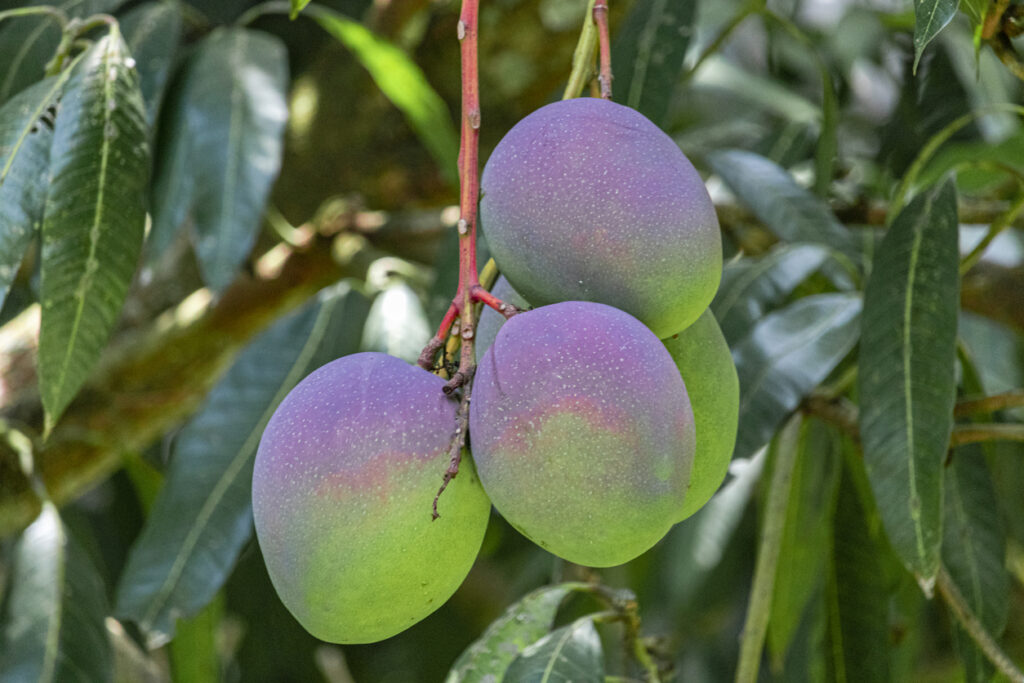
- Açai
- Acerola
- Avocado
- Bananas
- Breadfruit
- Mangosteen
- Custard Apple
- Guava
- Durian
- Tropical Figs
- Rambutan
- Lychee
- Dragonfruit
- Papaya
- Mango
- Passionfruit
- Granadilla
- Soursop
- Starfruit
Bananas might have a special role in human nutrition: Do bananas contain B12? Bananas are popular as nutrient and mineral-rich fruit. Lately, it is being mentioned as a plant-based source of vitamin B12 – which is very surprising, given that B12 is found in animal-based foods and is produced by microorganisms! Do bananas really contain vitamin B12? Recent studies describe banana pulp and peel as a source of vitamin B12. See here, here, and here. A vitamin B12-containing fruit is something that would contribute to a shift in dogma concerning B12 and plant-based nutrition. I can’t fully grasp the idea of a B12-containing fruit yet – it’s too good to be true!
Traditionally, bananas were used to combat anemia, which could be due to two key nutrients for blood building: iron and vitamin B12. The iron content is sometimes described as low and sometimes as high. Such contradicting information is not surprising considering the differences in the quality of the fruits. I assume that the vitamin B12 content of bananas is variable, too, and I would not consider them a reliable source, especially if you cannot get high-quality produce. Further, there is a lack of information on the type of B12 found in bananas, whether it’s a bioactive form of cobalamin or pseudocobalamin.
This topic is highly relevant for plant-based diets, and more research on whether bananas can be a B12 source for humans would further aid in understanding the human diet and the role of tropical fruits in it! Read more about bananas.
Not all fruits of all plants are edible for humans; in fact, there are many toxic fruits! Those fruits have not co-evolved as a human food source! Read more here.
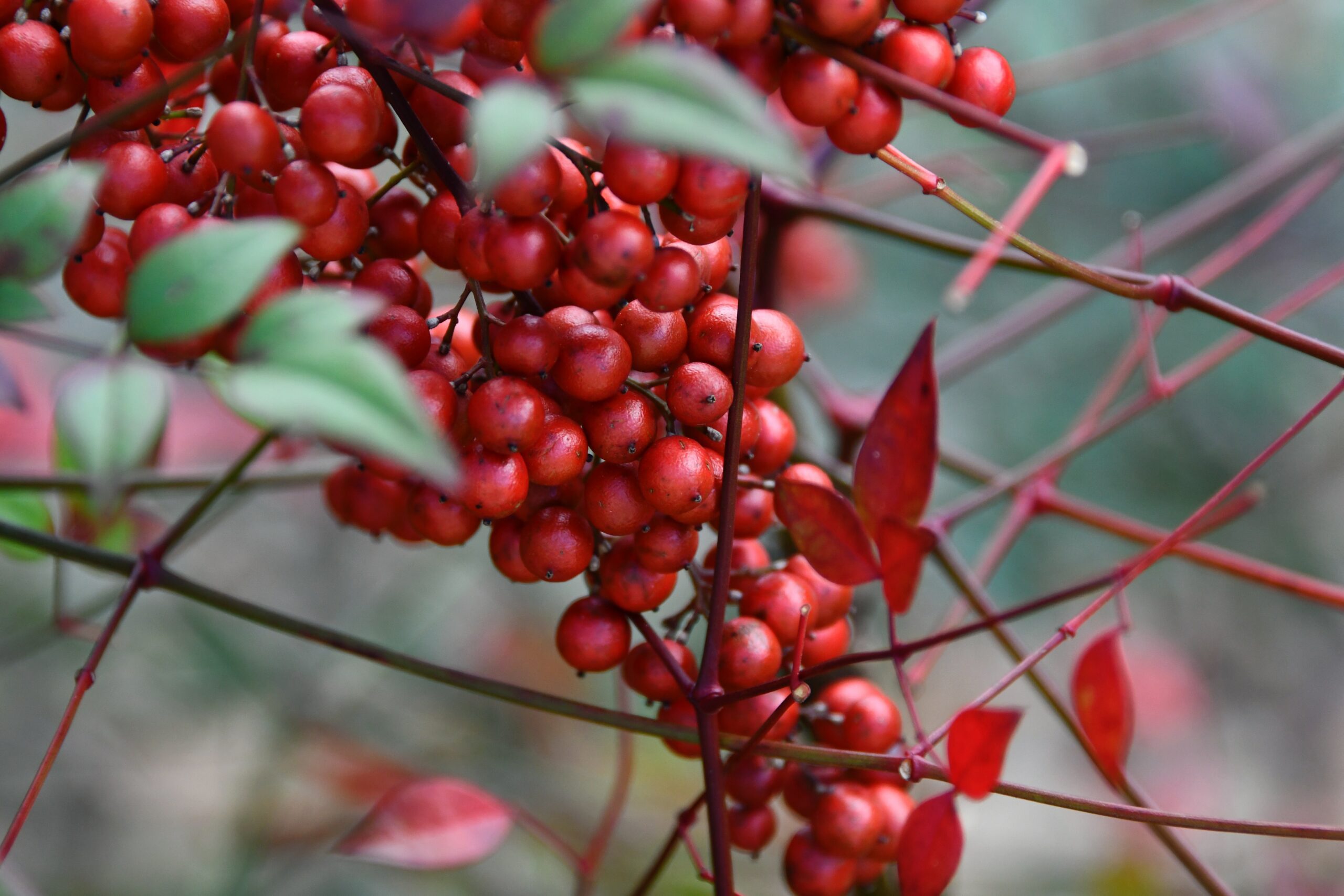
What are fruits botanically?
Botanically, fruits are the seed-containing fleshy parts of a plant that develop from a flower. Fruits are unique as a food source because of the symbiotic relationship between plants and fruit consumers, which shapes fruit traits and nutritional profiles in the course of evolution. This dynamic is called dispersal syndrome:
Fruits are also the plant part that attracts and rewards seed-dispersing animals. Many flowering and fruit-bearing plants depend on animals to disperse their seeds (unlike wind-dispersed species).
Therefore, they attract the animal with its colorful and smelling fruits to be consumed and have its seed dispersed. The animal has the reward of energy- and nutrient-rich fruit flesh.

The more nutritious and tasty fruits are, plus the less toxic fruits are to their consumer, the more successful the plant is in reproducing!
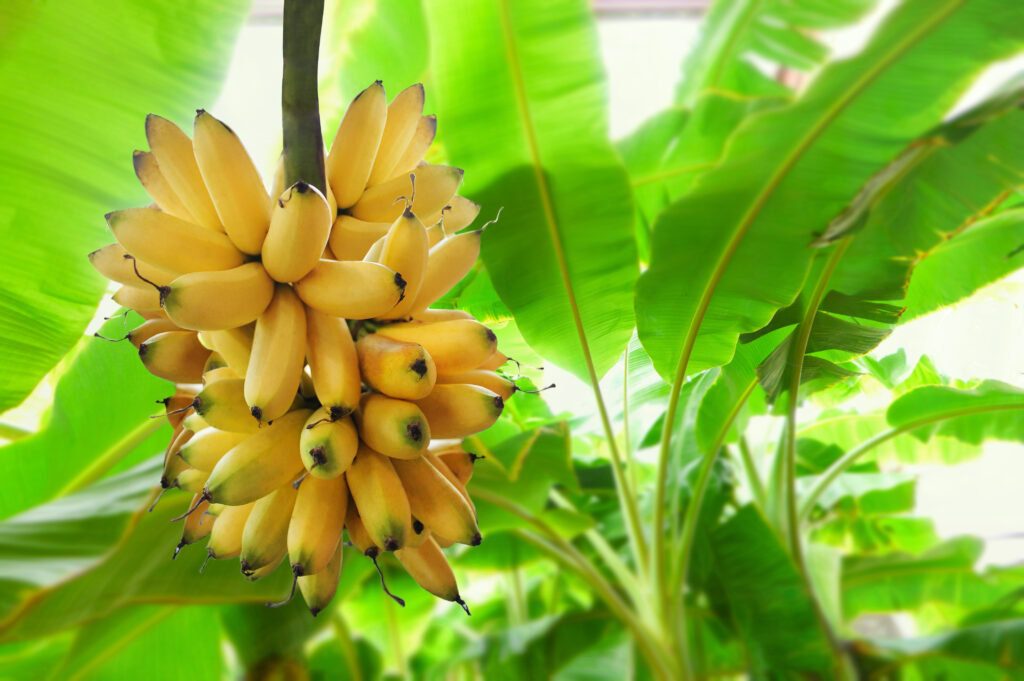
Nutrition
Fruits are the nutritional reward for the animal and contain energetic nutrition, simple sweet sugars, water-soluble vitamins, macro minerals (i.e., potassium), and trace minerals like boron, silica, and even low levels of protein and lipids (fat). Fruits are made up of living cells, which always contain all nutrients! They also contain fiber and a lot of naturally purified water.
Anti-nutrients
Because fruits are “intended” to be eaten by the plant, they are not protected with potent phytochemicals to keep consumers off – unlike all other parts of the plant. Some exceptions are fruits that have not evolved with primates but rather as food source for birds. However, some of those fruits have been bread to become edible.
What type of fruits is the healthiest?
The healthiest fruits for humans are the fruits that have naturally coevolved with our ancestors, which are most of the edible tropical fruits today! Here are some thoughts:
- Edible tropical fruits are ideal for humans: tropical fruits are mostly sweet and optimal for primates, including humans. Remember that we are originally tropical species and thus have evolved with tropical fruits. This matters in terms of a successful fruit-diet because tropical fruits have another nutritional profile than temperate fruits and also have less toxicity. This is reflected by the fact that most wild tropical fruits are edible for us, but most temperate fruits in their wild form are not!
- Temperate fruits are a good addition: temperate fruits are mostly acidic and were bread to be more suitable for human taste and consumption. They are a good addition to a fruit diet, but cannot replace tropical fruits. Those include apples, pears, plums, berries, apricots and the like.
- Some non-sweet “veggie”-fruits are suitable, and some not, i.e., cucumber, tomato, bell peppers, and pumpkins. They resulted from extensive breeding and originated in colder areas and thus have not evolved as primate foods. Moreover, some can be inflammatory because they still have some secondary plant compounds that can be toxic to humans, especially nightshades like tomatoes, bell peppers, and eggplants. This is why some people can have a sensitive reaction to those fruits, and some are not suitable for raw consumption. Read more on vegetable fruits here.
Acidic temperate or subtropical fruits often contain smaller seeds, as they originally evolved with birds that disperse their tiny seeds (swallowing).
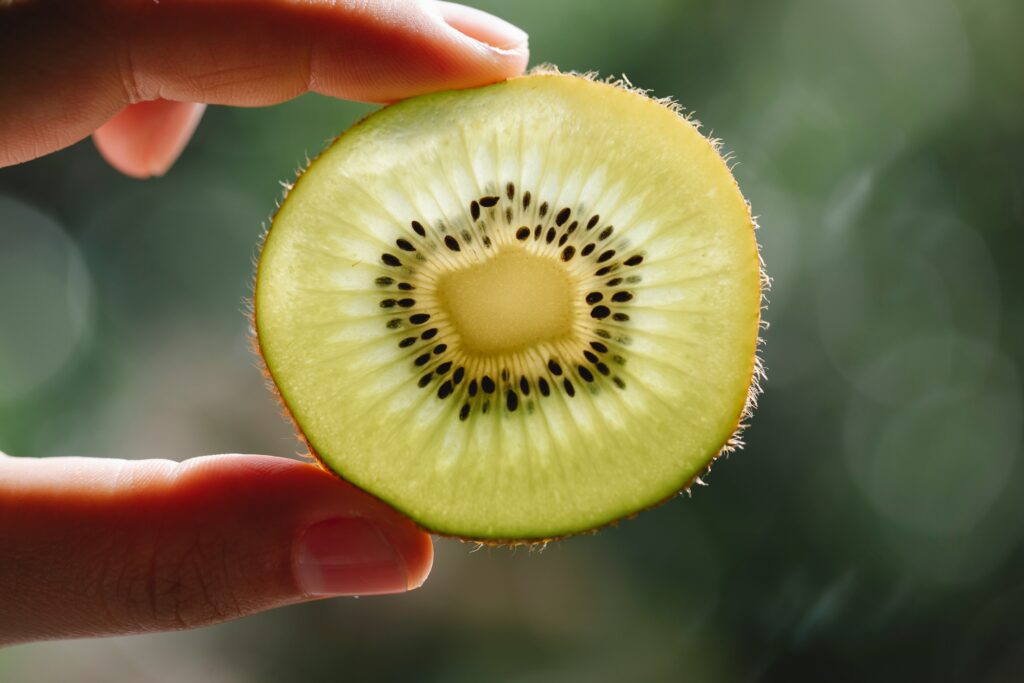
2. Nuts
Like with fruits, especially tropical nuts are optimal for humans. Nuts, however, should not make up a larger part of the diet than 10 – 20 % because of their anti-nutrients.
What are nuts botanically?
What we call “nuts” is a botanically diverse group with similar nutritional features. True nuts are hard fruits, but some nuts are seeds, mainly from trees (as opposed to grains, which are seeds from grasses), and some are other plant parts (like cashews). Thus, depending on the nut type, they do or do not have a symbiotic relationship with their consumer. Chestnuts, walnuts or pecans, and hazelnuts are examples of true nuts (fruits), while pine nuts, almonds, and pistachios are technically seeds. These “seed nuts” are the only type of seeds that are part of a frugivorous, species-appropriate diet.
The coconut is a nut, which is eaten by many frugivorous monkeys and serves as an important staple foods for humans, too. The seed of the coconut is the white water-holding flesh. The mesocarp is wooden-like and inedible.
The coconut is easier digestible than most nuts, as it contains only around 3.3 g of protein. It also contains important fat-soluble vitamins.
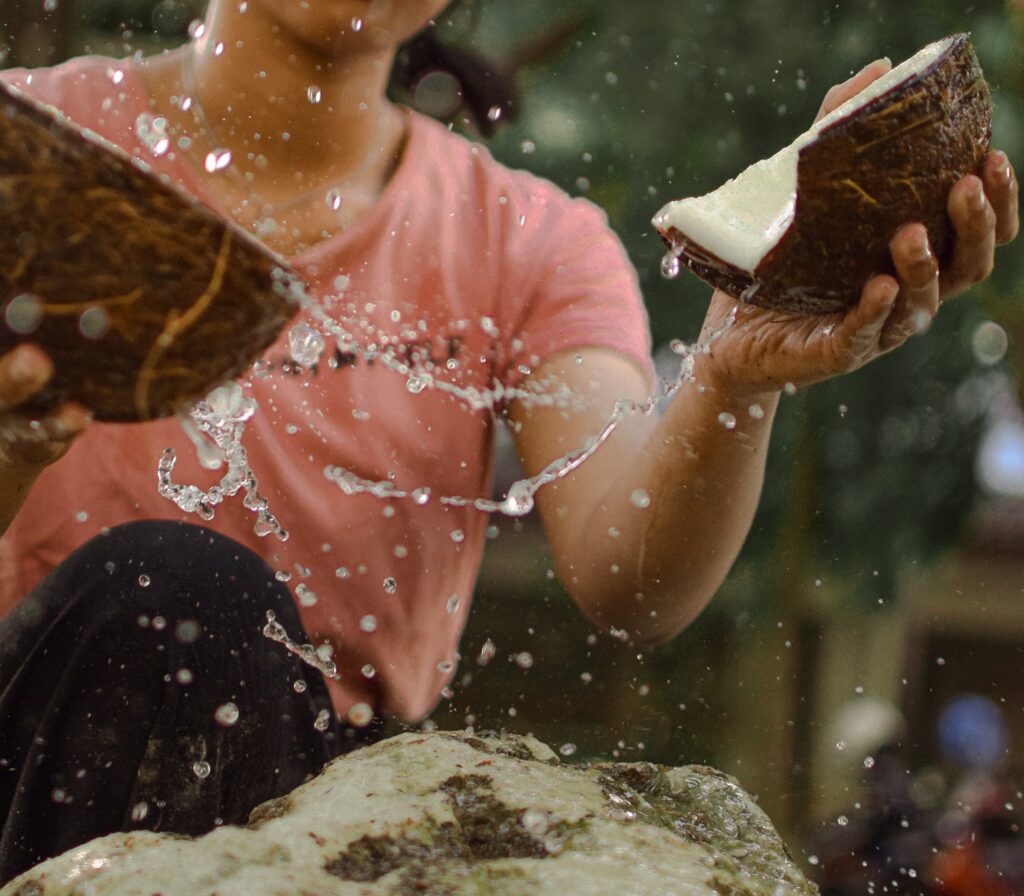
Nutrition
Nuts contain fats and fat-soluble vitamins, but also proteins and trace minerals, like iron, zinc, selenium, and chromium. Nuts are made up of living cells, which always contain all macronutrients! Besides being everyday food, nuts can be used as functional foods, i.e., for selenium supplementation with Brazil Nuts.
Anti-nutrients
Because nuts are not “intended” to be eaten, they are protected with potent phytochemicals to keep consumers off. If we eat nuts that have evolved as a food source for primates, we likely have evolved a high tolerance for the plant-protective compounds.
3. Greens and seaweed
Tender leaves and greens are a substantial part of a natural frugivorous diet, and we should eat plenty of it daily (read our in-depth article here). However, unlike folivores (specialized leaf-eaters) or herbivores (green plant-eaters), we are not strongly attracted to cellulose-rich foods (darker leaves/greens) in nature. Nor are we equipped to effectively digest them or process huge amounts of the secondary plant metabolites (see below).
Tender leaves are a significant source of protein and minerals for apes (read here). In contrast to most humans, apes have access to their natural food sources, tropical green leaves, which many of us do not. One way to get nutrition from greens – besides lettuce, microgreens, and green powders – extracts (teas or powder) from dried tropical leaves, like mango leaves, guava leaves, or graviola leaves.

What are green plant parts botanically?
Greens are the leaves and non-woody stems or branches of a plant. Green parts of a plant grow above the soil surface: The green-colored pigments capture sunlight for the plant’s sugar (energy) production – photosynthesis. The sugars are then transported throughout the plant, stored in the roots, or brought to the fruits to attract fruit-eating animals. The green parts are, therefore, the power generators of plants and ultimately provide all energy for animal life.
Note: fruit veggies like cucumber, squashes, tomatoes, etc. are often categorized as vegetables because they are not sweet. But they are the fruit of the plant. In contrast, vegetables are all other parts of the plant than fruits. Therefore, here in this biological approach, veggie fruits are in the fruits section, not the vegetable section (see above)!
Nutrition
Green plant parts contain chlorophyll and, therefore, a lot of magnesium, as well as other minerals and vitamins. Remember, leaves and all plant parts contain living cells that – by nature – must contain all components of a living cell: carbs, lipids, proteins, and vitamins. Similarly to fruits, greens also contain fiber and purified water.
In watery young light-green leaves, the minerals are more bioavailable. Unlike herbivores, we are not adapted to extracting all of our nutrients from greens. Herbivores have complex digestive systems and microorganisms to digest.
Seaweeds are leafy plants from the sea. They contain other nutrients and minerals than greens that grow on land. Iodine is the key nutrient in seaweed that is important for human health – and can be a cause of concern when not living close to the iodine-rich sea.

Anti-Nutrients
The plant protects green parts against being eaten, which is why most green plant parts contain phenolic defense compounds (Chowdhary et al., 2021). Those potent chemicals can be used as medicine. However, they should not be eaten in large amounts by frugivores (herbivores are better adapted to those compounds). Naturally, our taste buds indicate what is palatable and what is not. For example, bitter taste is off-putting, as it signals toxicity – bitter taste makes animals avoid eating something!
We should only eat as much of the green parts of plants as we could eat in their “natural state” – following our instincts. Lettuce with salad dressing or kale in a smoothie, for example: Would you eat as much lettuce or kale as is – without seasoning and mixed with fruit? Because the seasoning or the fruit covers the natural taste and prevents our body from sending the “right” signals. Crazily mixed smoothies are not necessarily the best option.

What makes a leafy green salad actually appealing are the veggie-fruits. What makes greens tasty is the fruits and/or the dressing (sugar, oil, salt).
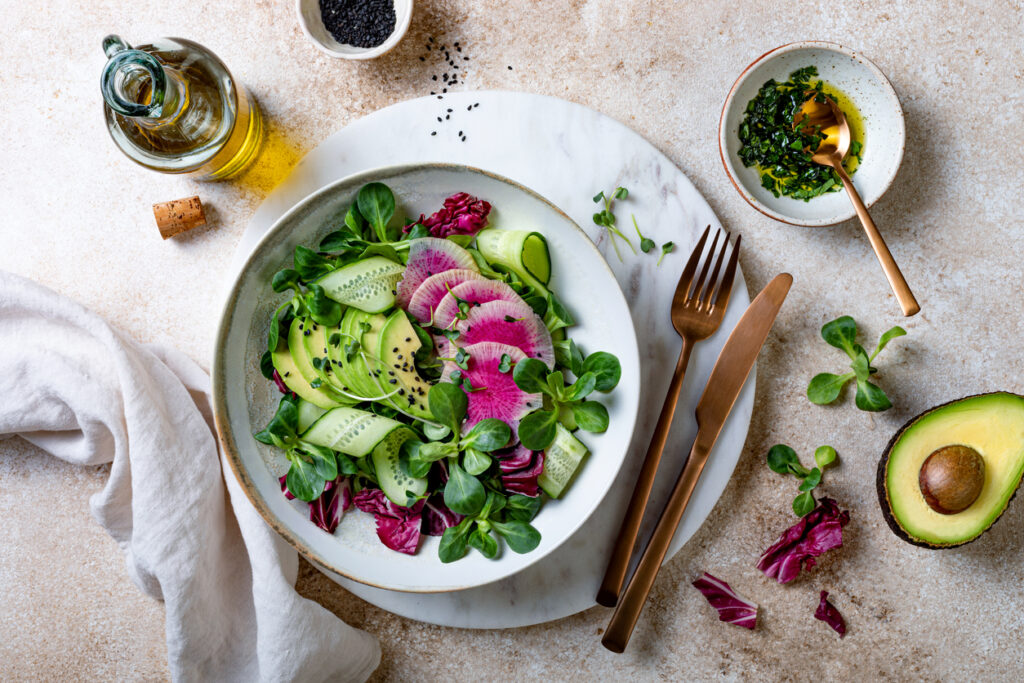
4. Root Vegetables
Root vegetables are not frugivores’ first choice, but they can be fallback food. Roots can substitute the carbs from sweet fruits in form of complex carbs (not sweet, though).
However, as frugivores, we prefer picking sweet fruits from trees to digging for roots because our hands are more suitable for foraging for fruits than digging.
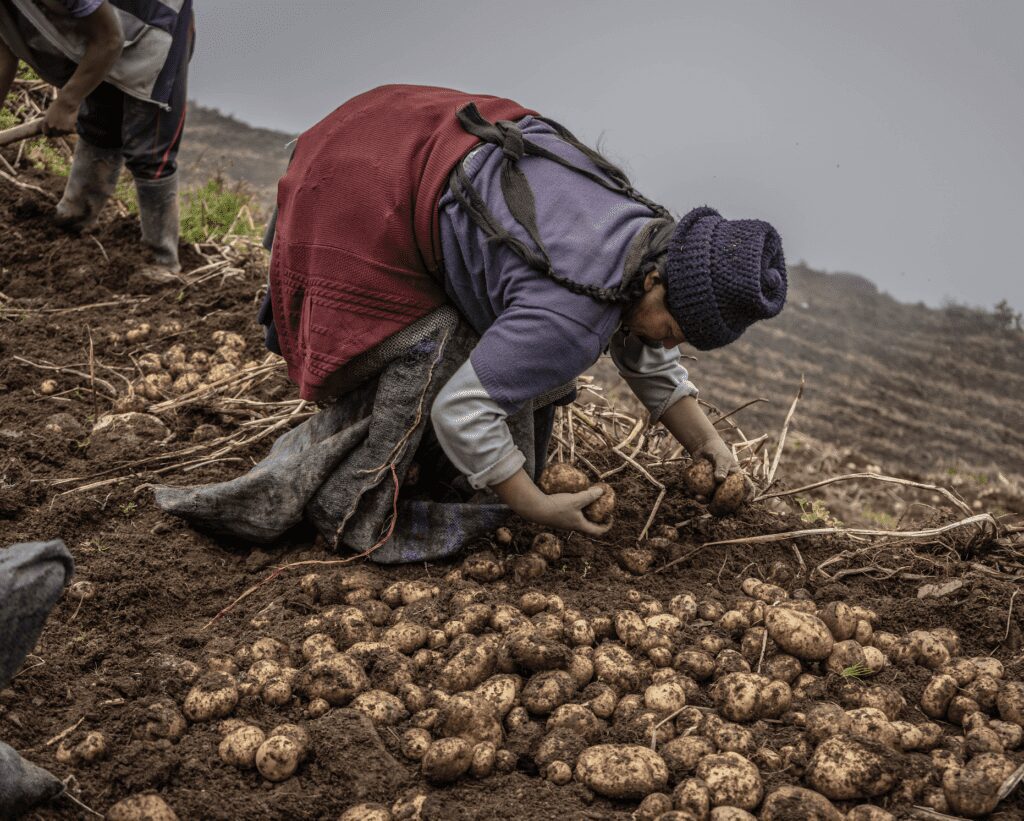
Cooking makes the complex carbs (starches) better available, similar to fruits. As a special cas, potatoes are from the toxic nightshade plant family and are toxic raw, and thus are not suitable as food for humans.
What are roots botanically?
Root vegetables are root parts of a plant and grow within the soil. Roots are made for inorganic mineral, water and nitrogen uptake from the soil. Nitrogen builds the basis of protein production!
Some plants store a bulk of energy in the form of starches (complex sugar) in their roots. Those are the ones we tend to eat as food plants. However, not all root vegetables are starchy, but also contain glucose (simple sugar, sweetish). They are similar in this way to fruit-vegetables. The only difference is that the root is produced as a store for the plant and not – like the fruit – for the consumer. Root and stem vegetables can be consumed in any amount, but only eat as much as you would eat in their “natural state.” Example of celery juice: Would you eat so much celery just like that?
Nutrition
Roots contain energetic nutrition in the form of complex carbs and simple carbs, but also minerals and water-soluble minerals.
Besides starchy roots, we have watery roots with more simple (sweet) carbs that are edible in their raw state.
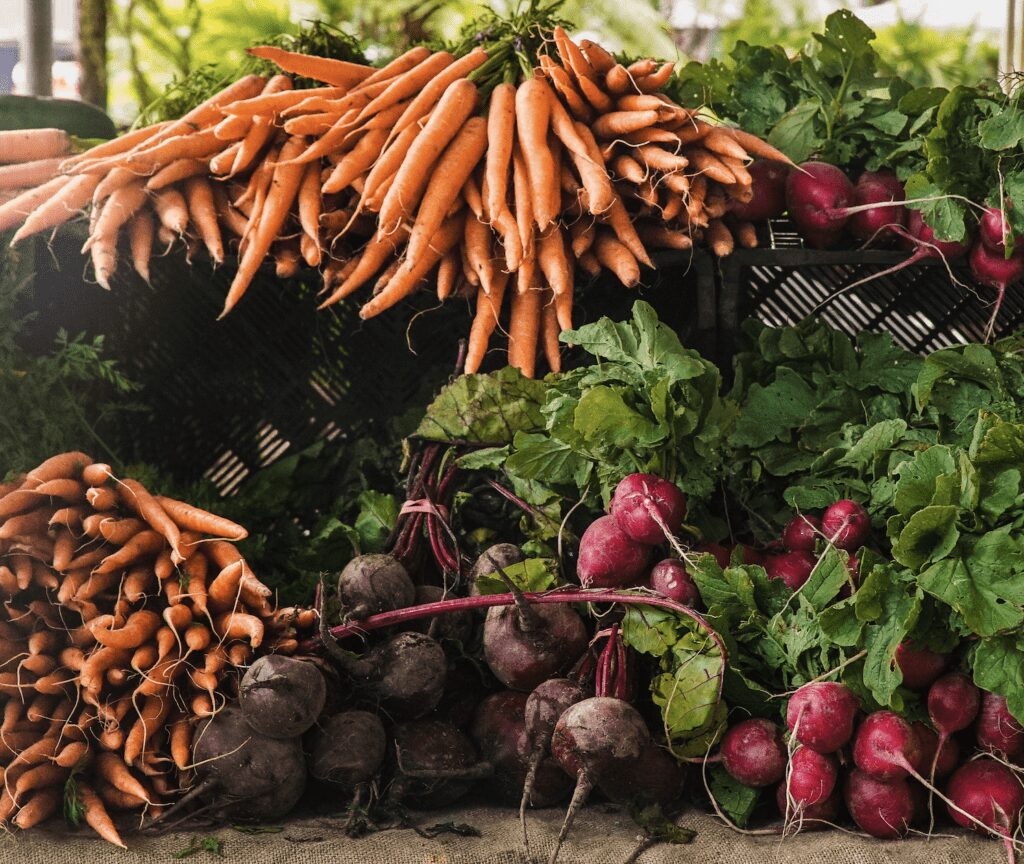
Anti-Nutrition
All modern root vegetables are the result of extensive breeding and cultivation. As a result, most natural roots have potent phytochemicals (as self-defense of the plant) and are not palatable. This is why many plant roots are used in phytomedicine but in small quantities, not as a food source.
5. Grains, Legumes, Pseudo-grains, Seeds
Grains (seeds of grasses) and legumes (seeds of leguminous plants) are not suitable foods for humans and are difficult to digest even after cooking. Some substances in legumes are so toxic that they are still toxic to humans, even after soaking, boiling, or sprouting. They are only suitable foods for highly specialized grain-eaters (granivores) but not for a species that is naturally not adapted to those compounds.
Nonetheless, cooked grains are important survival food, because they can substitute the carbs from sweet fruits in form of complex carbs (not sweet, though).
What are grains, legumes botanically?
Seeds, grains, and pseudo-grains contain the embryos (and thus the potential progeny) of the according plant. The embryos are chemically protected from being eaten by the plant – which means the plant tries to put off animals by producing toxins.
Symbiosis results in low plant toxicity: Seeds in fruits for frugivores have another function: seeds usually pass the digestive tract unharmed (or even benefit from this process) and thus do not serve nutrition but instead are dispersed via defecation (Corlett, 2017). In contrast, grain-eating animals (granivores like birds, rodents, and insects) digest the grains, destroying the plant’s progeny. These two different evolutionary relationship types (symbiosis vs. preying) result in low vs. high toxicity because the plant’s protection is through toxic chemicals.
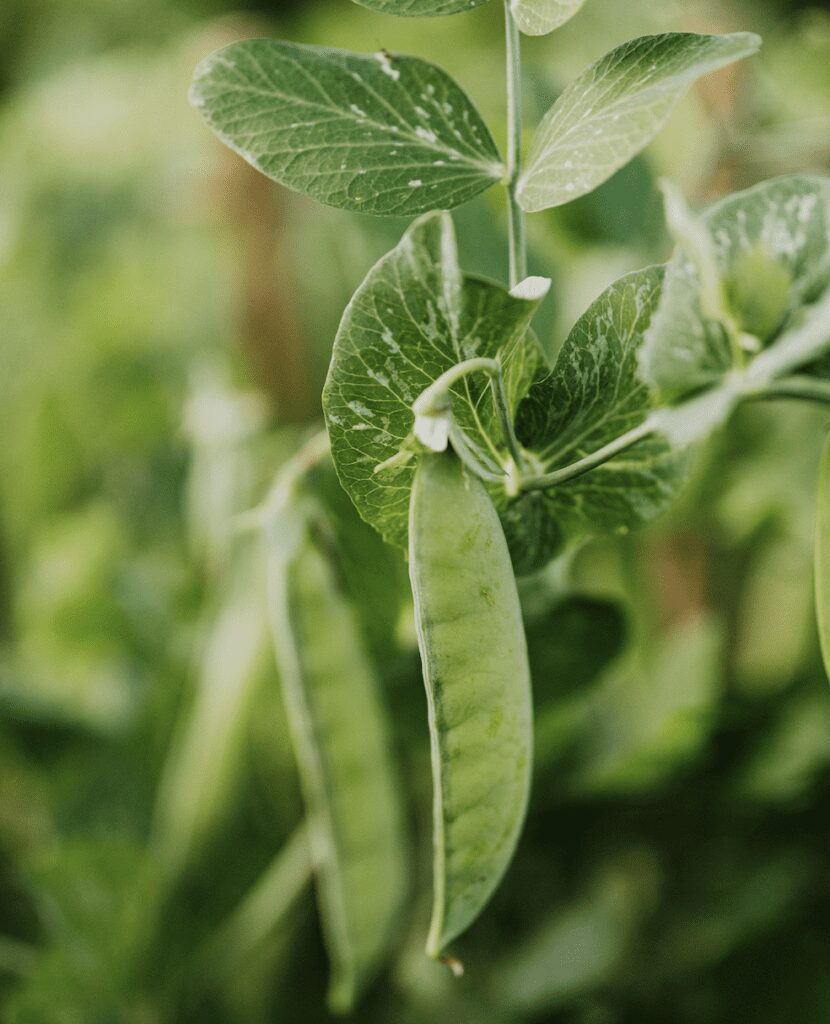
Nutrients
Grains and legumes contain a good amount of carbs and proteins. Those nutrients are only safely accessible for frugivores through cooking. Cooked complex carbs are the fallback substitute for the simple carbs in fruits.
Anti-Nutrients
Seeds are the embryos of the plant, the next generation, which is especially well-protected from predators with often toxic substances (a type of natural pesticide). These are so-called “anti-nutrients” because they interfere with digestion, and the nutrients are no longer well absorbed (read here more about legume toxicity).
The explanation of seed toxicity is easy to understand: the protection of the next generation is crucial to a species’ survival. Thus, those plants that have the right genes to avoid being eaten effectively, will bring effective natural pesticides into the seed. Good for them, not good for us, as we are not adapted to those toxins like granivores (seed-eaters).
In countries where many legumes are eaten, the insidious poisoning “lathyrism” caused by certain legumes is also known. This shows that these plant parts stress the body due to the protective toxins.
Grains are the seeds of grasses, which in nature are the food source of granivores like insects or rodents. Examples are rice, wheat, or even corn.

Because of the compounds in grains and legumes, many people experience an improvement in their health simply by avoiding grains and their products, such as pasta, bread, and dough, but also legumes, such as beans, lentils, and peanuts.
Read more about getting carbs from grains versus fruits, here.
6. Mushrooms
Bonobos (chimpanzees) have been found to eat mushrooms in the wild. Humans are able to eat many types of mushrooms raw. Edible fresh mushrooms can be eaten raw. However, they are not a frugivore’s first choice in larger quantities:
Fungi are a distinct biological group. They are difficult to digest and not very appealing to us in their natural state. Nor do they taste really good in larger quantities without being seasoned, salted, cooked, roasted, or the like. Most wild mushrooms are very poisonous. Only some cultivated mushrooms can be eaten raw. However, mushrooms are well suited for the switch from meat to vegetables and are a great “survival food” when living in colder climates.
7. Eggs
Eggs are also part of the frugivorous diet of chimpanzees. It seems that raw eggs are less off-putting for humans than raw meat. Still, they are not really appealing – unless maybe we are really starving!
There is also the issue of widespread allergy against egg proteins. A problem that is linked to the application of modern egg-produced medications…

8. Meat, Fish, Insects and Seafood
Meat and insects are a part of the (frugivorous) diet of chimpanzees in the wild – but it makes up a very small amount and raw. Some individuals highly likely do not eat meat at all (read more here)! Moreover, human instincts do not find those foods appealing, but they may be considered survival foods.
Humans have no hunting instincts (nor anatomical hunting traits) and would not consume raw, bloody meat like carnivores. However, for survival, humans cooked meat to make it palatable and safe to eat. For this reason, meat is not a preferred (optimal) food but a survival food.
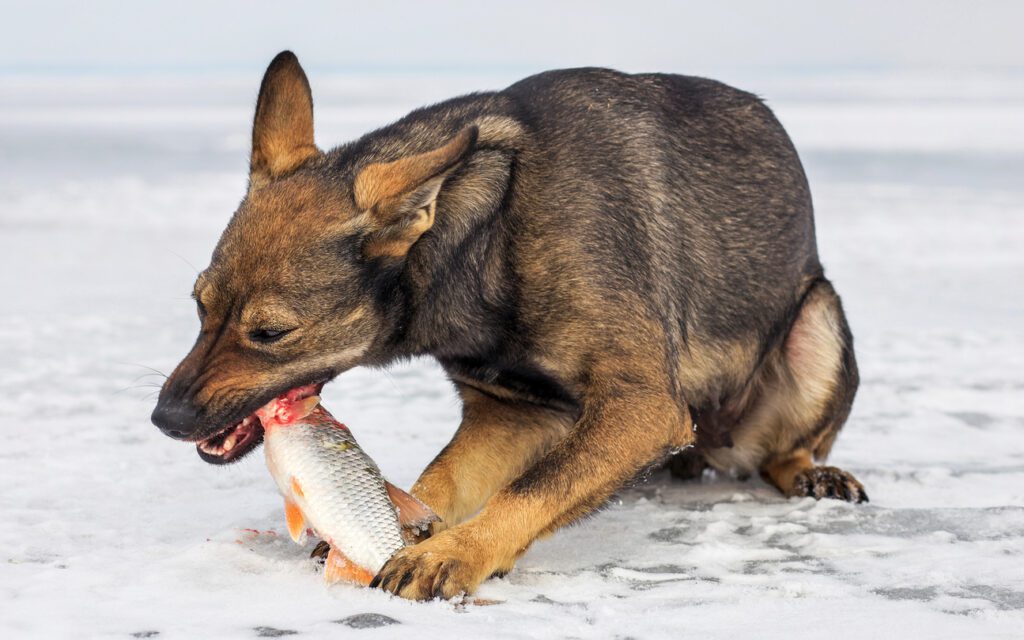
We are not adapted to metabolize as much protein like a carnivorous species. Even small amounts of animal-based foods quickly exceed the amount of protein that is safe for the kidneys!
Learning intuition from children: During the holidays, my 7-year-old daughter and her friend saw fishermen pull a small shark ashore to kill it. They fell away crying in terror and mourned for him all day. Zero hunting instinct! Unlike a baby lion or cat, which have inborn instincts to hunt and eat raw meat.
Most of us do not like raw meat like carnivores do – we feel repulsed even to see others eating it:
9. Dairy
Milk and eggs are products of animals that contain everything to nourish the growing offspring. Milk was and is a practical survival food in many regions outside the tropics. However, it is not optimal for our digestive anatomy and physiology. Additionally, modern milk is also often heavily processed, i.e., heated and contaminated by medicines that are regularly administered to the animals. Additives are then added to dairy products.
If you consume dairy products and/or eggs, it is essential to pay attention to the quality (Demeter, organic, if possible raw for dairy products). In some cases, dairy can be used as a functional food, especially when living in a cold climate, where the foods of a raw, frugivorous diet are difficult to access. However, there are downsides to dairy, like hormonal effects and preventing effective iron uptake. Read our in-depth article on dairy to understand the role of it in the human diet.
10. Meat and Dairy Alternatives
Most substitute products are not recommended, as they are not natural, and even less are they appropriate as species-specific foods. However, there are exceptions:
No: Plant-based alternatives for dairy and meat are mostly made from grains, nuts, soy, and legumes like beans, lentils, and chickpeas (see above) with additives that enable the “right” consistency. Most of those products are also filled with inflammatory plant oils.
Yes: Homemade nut milk can be species-appropriate and integrated into a frugivorous human diet. Additive-free, organic coconut milk, and other products are a tropical, tasty addition to the diet! Coconuts are eaten by primates in nature.

11. Isolates
There are various types of isolated compounds used in our foods. Isolates are hardly ever a good idea, as they are not in their natural composition and lack the interactions they have within a complex system. Under some circumstances, however, isolates can be used in a functional way when the natural (optimal) way is not an option (i.e., not available).
There are different types and levels to this.
Artificial food additives: Avoiding artificial additives is non-negotiable. They need to go! They serve no purpose in diet, but certainly have the potential to be harmful.
Isolated sugars: Sweet taste indicates nutrition to us. It shows us when the fruit is ripe, i.e., when it contains energy-carrying simple sugars to fuel us. In comparison, carnivores don’t taste “sweet” at all. A lot of people don’t like fruit that much these days because we have a hard time getting hold of good, ripe fruit. For example, if we don’t find smoothies tasty enough, we can help with natural sweeteners like raw honey (as the fruit should actually be) or coconut sugar. It is, in some way, a substitute for the sugar from naturally ripened fruit. It’s not optimal, but it is sometimes the best option to imitate our natural diet. The more natural the sweetener, the better.
Isolated fats: In nature, we do not find isolated oils and fats. Within natural foods, lipids are within a complex matrix – like any food that is made up of whole cells and not isolates. Thus, isolated fats are not a species-specific food.
Salts and seasoning: Spices, herbs, and salts are taste enhancers and aromatic parts of plants that have a bioactive effect in large quantities and are, therefore, also used as natural remedies. They also serve as natural food preservatives. The intense taste and aromatic flavor prevent us from consuming too much herb or salt. For example, it is not palatable to chew and eat a bunch of basil at a time, but mixed in a salad with seasoning, we eat more than we would naturally. The amount is crucial here. In addition, we should focus on eating mostly foods that don’t need any seasoning/salt to taste good but taste good to us naturally. But again, sometimes it’s the best option we have at hand!
Isolated nutrients: Under optimal conditions, when we live in our natural habitat, which is tropical, eating a human species-specific diet, we do not need isolated nutrients. However, this is not the case for most of us, which is why we sometimes can use isolated nutrients to address this unnatural problem. Functional foods are often the better choice than isolated chemistry. However, this is not always possible. Visit our supplement guide for more info.
Naturally, we don’t need extra added isolated fat and sugar to complete our foods when we live in our original natural habitat that provides abundant tropical fruits and greens. However, isolates and extracts can be used for functional nutritional purposes, like deficiencies, or for medical use, such as herbs.
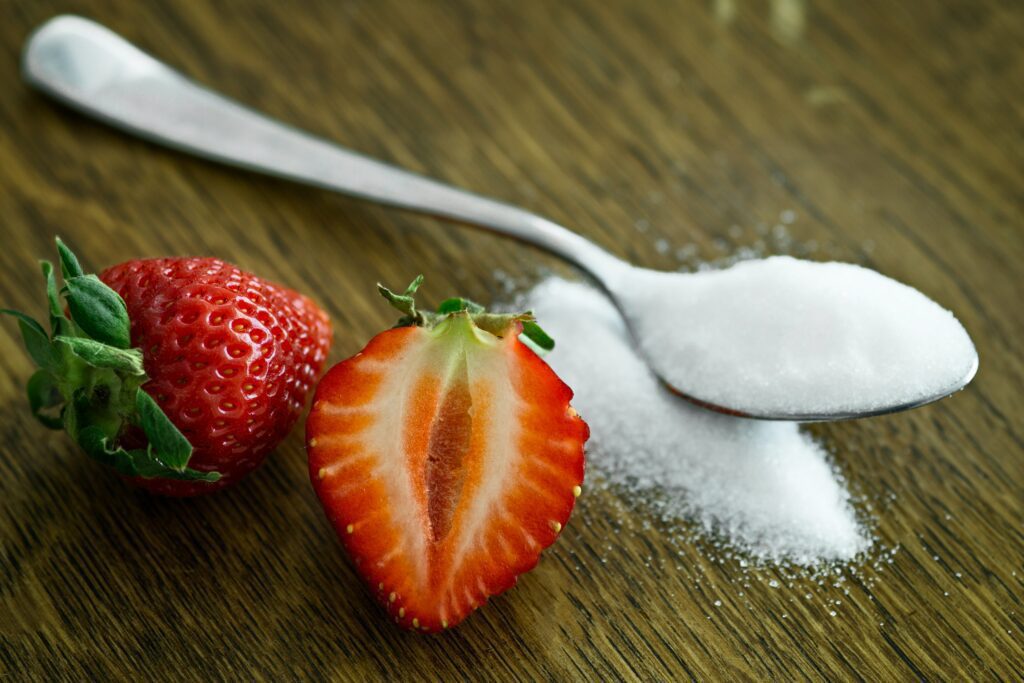
12. Highly Processed “Foods”
Processed foods such as packaged products like french fries, biscuits, mayonnaise, frozen pizza, ice cream, chewing gum, and the like are to be avoided and are clearly not natural foods – or foods at all. The ingredients are often isolated substances that are “mixed” together to make them palatable to us. In addition, there are often synthetic additives and stabilizers, which are to be avoided completely.
However, if such products are still consumed (or someone you know consumes them), buying organic quality can make a big difference: many (of the most harmful) additives are not allowed in organic products.
Conclusion
There are no standard answers for everyone because we live in different regions and have different levels of health. Some can transition fast into a high-fruits diet, while others, for example, cannot (yet) digest fruits or raw foods well due to pre-damage to their body.
This is not reductionistic science but rather the bigger picture and ecological patterns that have been out of the picture in nutrition for too long!
By learning more about our foods’ properties, we can make informed decisions and understand what is natural and healthy in our diet.
For more information on how to adopt a high-fruit diet, check out our guide here.
Last update:
References
- Amini Khoozani A, Birch J, Bekhit AEA. Production, application and health effects of banana pulp and peel flour in the food industry. J Food Sci Technol. 2019 Feb;56(2):548-559. doi: 10.1007/s13197-018-03562-z. Epub 2019 Feb 8. PMID: 30906012; PMCID: PMC6400781.
- Isnaeni, I., Zufara, B.S. and Lewa, I.W. (2020) ‘Alternative optical methods for qualitative detection of vitamin B6 and B12 of Banana’, Jurnal Teknologi dan Industri Pangan, 31(2), pp. 147–154. doi:10.6066/jtip.2020.31.2.147.
- Grossman A. Nutrient Acquisition: The Generation of Bioactive Vitamin B12 by Microalgae. Curr Biol. 2016 Apr 25;26(8):R319-21. doi: 10.1016/j.cub.2016.02.047. PMID: 27115686.
- Oyeyinka, B.O.; Afolayan, A.J. Suitability of Banana and Plantain Fruits in Modulating Neurodegenerative Diseases: Implicating the In Vitro and In Vivo Evidence from Neuroactive Narratives of Constituent Biomolecules. Foods 2022, 11, 2263. https://doi.org/10.3390/foods11152263
- D. Sharma, S. Mishra, An acute toxicity in human health of raw and cooked vegetable in tomato and spinach. Food Science and Nutrition. 6, 1–6 (2020), doi:10.24966/fsn-1076/100075.
- Quick-start guide to nuts and seeds. Harvard Health (2021) (available at https://www.health.harvard.edu/nutrition/quick-start-guide-to-nuts-and-seeds).
- L. Streit, What is cellulose and is it safe to eat? Healthline (2021) (available at https://www.healthline.com/nutrition/cellulose-fiber).
- V. Chowdhary, S. Alooparampil, R. V. Pandya, J. G. Tank, Physiological function of phenolic compounds in plant defense system. Phenolic Compounds – Chemistry, Synthesis, Diversity, Non-Conventional Industrial, Pharmaceutical and Therapeutic Applications (2022), doi:10.5772/intechopen.101131.
- Y. P. Gupta, Anti-nutritional and toxic factors in food legumes: A Review. Plant Foods for Human Nutrition. 37, 201–228 (1987), doi:10.1007/bf01091786.
- R. T. Corlett, Frugivory and seed dispersal by vertebrates in tropical and Subtropical Asia: An update. Global Ecology and Conservation. 11, 1–22 (2017), doi:10.1016/j.gecco.2017.04.007.
- Jeremy, 10 surprising reasons to avoid eating legumes. Paleo Flourish (2020) (available at https://paleoflourish.com/paleo-why-legumes-are-bad).
- Monkey food. Ascopolyporus – fungus case study (available at https://www.anbg.gov.au/fungi/case-studies/monkey-food.html).






Add Comment